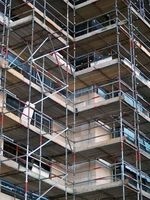Osha Scaffold Safety Requirements

Scaffolding is a kind of temporary structure used in the construction and repair of buildings and other large structures. The scaffold is used to support people as they carry out the repair or construction of the structure; as such, due care must be applied in the use of scaffolding in order to prevent accidents which could lead to injuries or fatalities. The Occupational and Safety Health Administration (OSHA) is the government agency in charge of the welfare of workers, and it has certain guidelines for scaffold safety.
Load
OSHA standards require that scaffolds must be able to support four times their recommended maximum load. Scaffolds should never be loaded in excess of the recommended maximum weight. OSHA require that any wire or fiber rope which is used in making scaffold suspension must be able to bear at least six times its intended load. Scaffold must be maintained and kept in safe working condition at all times and any scaffold which has been damaged, weakened or otherwise structurally impaired or compromised must not be used until all necessary repairs have been carried out.
Worker Safety
OSHA scaffold safety standards require that an access ladder must be provided for workers on a scaffold, and overhead protection must be provided to protect workers from overhead hazards in the form of falling debris. OSHA rules state that employees must not work on a scaffold in the event of bad weather, such as high winds or storms. Employees are not required to work on a scaffold which is covered with snow or ice. They can only work on such a scaffold if the snow and ice have been removed and the scaffold planking has been sanded to prevent any slips from occurring.
Other Scaffold Safety Rules
Tools and other materials or debris should not be allowed to accumulate on a scaffold to the point that they will constitute a hazard. A tag line must be attached to any material which is being hoisted onto a scaffold. Only wire rope-supported scaffolds should be used when acid solutions are used in the cleaning of buildings which are more than 50 feet in height, and only treated fiber rope or fiber rope which has been protected should be used around or for any work in which the use of corrosive chemicals or substances are involved. The legs, poles or uprights of scaffolds must be secured and braced rigidly to avoid displacement and swaying.
Load
OSHA standards require that scaffolds must be able to support four times their recommended maximum load. Scaffolds should never be loaded in excess of the recommended maximum weight. OSHA require that any wire or fiber rope which is used in making scaffold suspension must be able to bear at least six times its intended load. Scaffold must be maintained and kept in safe working condition at all times and any scaffold which has been damaged, weakened or otherwise structurally impaired or compromised must not be used until all necessary repairs have been carried out.
Worker Safety
OSHA scaffold safety standards require that an access ladder must be provided for workers on a scaffold, and overhead protection must be provided to protect workers from overhead hazards in the form of falling debris. OSHA rules state that employees must not work on a scaffold in the event of bad weather, such as high winds or storms. Employees are not required to work on a scaffold which is covered with snow or ice. They can only work on such a scaffold if the snow and ice have been removed and the scaffold planking has been sanded to prevent any slips from occurring.
Other Scaffold Safety Rules
Tools and other materials or debris should not be allowed to accumulate on a scaffold to the point that they will constitute a hazard. A tag line must be attached to any material which is being hoisted onto a scaffold. Only wire rope-supported scaffolds should be used when acid solutions are used in the cleaning of buildings which are more than 50 feet in height, and only treated fiber rope or fiber rope which has been protected should be used around or for any work in which the use of corrosive chemicals or substances are involved. The legs, poles or uprights of scaffolds must be secured and braced rigidly to avoid displacement and swaying.
- ts851fda1df15fc936b3738dc5107672c8.jpg
References
http://www.ehow.com/list_7258374_osha-scaffold-safety-requirements.html
http://img.ehowcdn.com/615x200/ehow/images/a06/tg/86/osha-scaffold-safety-requirements-1.1-800x800.jpg